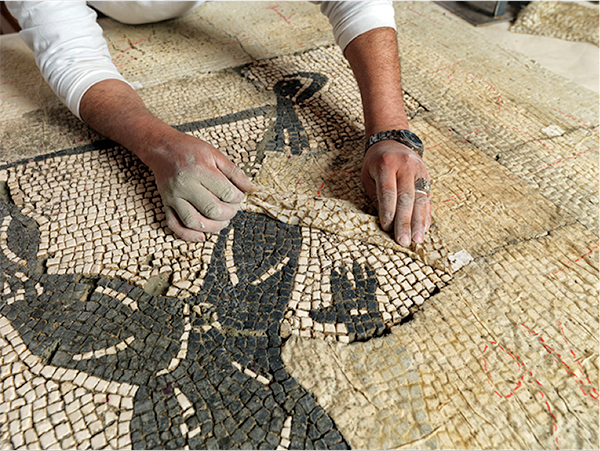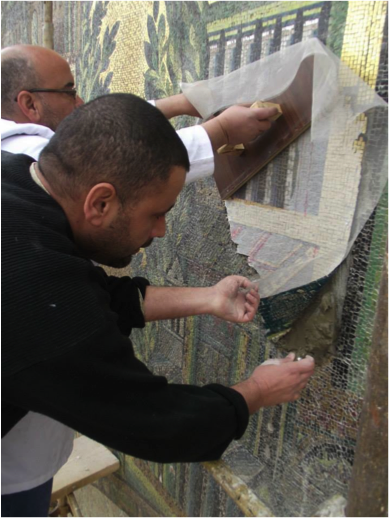
Few artistic media are more evocative of classical antiquity than mosaics. Composed of small pieces of colored marble, stone, glass, shell, and pottery fragments, the decorative floor mosaics that have survived the past several thousand years in the lands that were once part of the Roman empire are not only artworks of great beauty, but also important records of life in the ancient Mediterranean.
Since 2009 the Getty Foundation has contributed to a collaborative initiative to improve the preservation and care of mosaic heritage in the Mediterranean, both in museums and at archaeological sites. MOSAIKON is a joint program with the Getty Conservation Institute (GCI) in partnership with the International Centre for the Study of the Preservation and Restoration of Cultural Property in Rome (ICCROM) and the International Committee for the Conservation of Mosaics (ICCM).
A major pillar of MOSAIKON is training, and the Foundation has focused on grants that raise awareness for how to care for mosaics that have been lifted from their original archaeological context. Central to this effort is a partnership with the Centro di Conservazione Archeologica (CCA), an organization located outside of Rome and led by Dr. Roberto Nardi, one of the world’s foremost experts in mosaics conservation and the newly elected president of ICCM.

Roberto Nardi (center) with MOSAIKON training participants at CCA headquarters outside Rome
I caught up with Dr. Nardi recently on the occasion of the 12th triennial conference of ICCM in Sardinia to discuss about the training he has organized with Getty support, as well as a recent gathering of MOSAIKON alumni that provided some perspective on how the initiative has begun to impact professionals from the region.
Katie Underwood: Why don’t we start with an overview of the training effort you’ve led at the Centro di Conservazione Archeologica (CCA).
Roberto Nardi: The Mosaic Conservation Course (MCC) as we call it at CCA is a six-year training effort to reinforce capacity for preserving ancient mosaics in the Mediterranean. Our goal is to foster a new generation of conservators, instructors, and laboratory directors who can work as a team at a regional level to tackle the complex issues linked to mosaic conservation. Currently we are in the process of implementing the second step of this training program funded by the Getty Foundation, with a focus on professionals in Syria, Jordan, Tunisia, and Libya.
Challenging places to work to say the least, given recent events in the region. How have you managed to implement training in the midst of great turmoil?
When we designed the Mosaic Conservation Course, we initially thought we would conduct workshops in the participants’ home countries by conserving mosaics under their care, the first being a workshop in Damascus. But when conflict intensified, we revised our plans and offered training at CCA’s headquarters about an hour’s drive from Rome. As it turns out, this approach has been terrific in terms of building a professional community and fostering a spirit of collaboration where participants can work together without some of the distractions of home. Since this is one of the goals of MOSAIKON, we’ve continued to host training at CCA.
Speaking of building community, I understand that one of the ways you’ve done this is staying in touch with program alumni.

Participants in the recent MOSAIKON alumni meeting in Alghero. Photo courtesy CCA-Roma
Yes, we recently held a meeting for eighteen alumni of Mosaic Conservation Course training workshops in Alghero, Sardinia, before the ICCM conference, which brings together mosaics professionals from all over the Mediterranean and beyond. Each of the 18 participants gave a presentation on the work carried out in their institution after taking part in the Conservation Course. This was followed by a discussion on the current state of mosaic conservation in the Mediterranean region.
Did any common themes emerge from their presentations?
Many touched on the importance of adequate documentation during and before conservation treatments, research on alternative backing supports to provide structural protection for lifted mosaics, and the damage caused to mosaics by past interventions that used inappropriate materials, as well as the damage resulting from current conflicts within the region.
So I gather that Mosaic Conservation Course participants have been able to put the skills they acquired to use after they returned home.

Participants in the 2011–13 MOSAIKON training course organized by CCA conserve damaged mosaics on the façade of the Umayyad Mosque in Damascus, Syria. Photo © DGAM Syria
Absolutely. Let me share a few stories from Syrian participants. Dr. Komait Abdallah, director of the Scientific Laboratories of the Syrian Directorate General of Antiquities and Museums, was one of the meeting co-chairs, and he spoke about how the Getty-supported training has given Syrian trainees the confidence and technical means to implement challenging projects, such as the conservation of mosaics from the Umayyad Mosque in Damascus, carried out by Mosaic Conservation Course alumni Borhan Alzraa and Mohammad Al Kaeed, among others.
Their colleague Maher Jbaee reviewed several case studies on recent conservation work carried out in Syria to highlight how professionals working in the field have benefited from the MOSAIKON courses. In particular, he noted improved intervention planning and management, as well as greater care taken with appropriate documentation. This was an aspect that was frequently ignored in the past, causing significant loss of information. Finally, the Mosaic Conservation Course has had an important role in “training the trainers”: the first group of participants from Syria from several years back started to offer beginning-level training when they returned home, and one Syrian student they trained, Moutaz Alshaeib, just took part in the most recent course earlier this fall.

CCA training participant Moutaz Alshaeib presents at the MOSAIKON alumni workshop in Alghero. Photo courtesy CCA-Roma
The presence at this meeting of so many professionals from countries that are going through difficult times, and who managed to attend despite the obstacles, is a sign of their high-level commitment and professionalism.
What comes next for your work with MOSAIKON?
For CCA, we will continue our training efforts and also continue to support the professional networks that are starting to take shape through activities such as the alumni meeting. The meeting was an occasion to exchange ideas and learn from one another, strengthening the awareness of being part of a community that transcends regional boundaries and works with shared objectives across the Mediterranean region. But all this does not end after the training is complete or the meeting is over. We stay in touch through social media and through ICCM as our professional organization, and these lasting connections forged through the Getty’s support are as important as the skills that MOSAIKON participants gain.
Monther Jamhawi, director general of the Jordanian Department of Antiquities, who also chaired the recent meeting, summed it up well when describing the great responsibility for the challenges faced by mosaic professionals in his own country: “It is time to share responsibilities, not only by having them [the Jordanian professionals] participate in similar training courses, but also by listening to them when they come back, sharing their knowledge and building together a framework to safeguard our heritage.”
Text of this post © J. Paul Getty Trust. All rights reserved.
_______
To learn more about MOSAIKON and the training at the Centro di Conservazione Archeologica (CCA), see CCA’s blog, as well as this recent article in the Los Angeles Times.




Comments on this post are now closed.